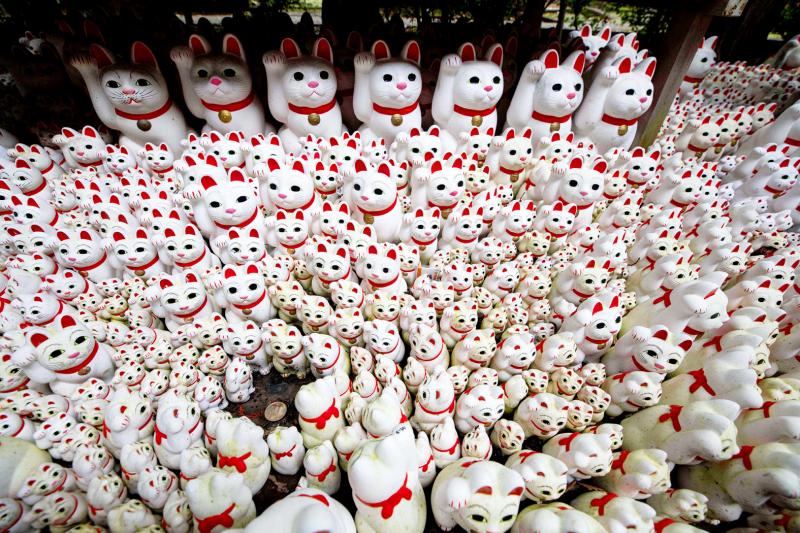In Japan — where they take their cats very seriously — they call Yuki Hattori the Cat Savior. He is so popular that he saw 16,000 patients last year, and crowds regularly queue up to hear him talk about neko no kimochi (a cat’s feelings), while people from all over Japan make the pilgrimage to his practice. Sometimes clients turn up from further afield.
“One flew in from Iraq for a personal consultation,” Hattori says, “without his cat, due to border quarantines.”
In Japan’s rarefied world of cat doctors, the vet Hattori is very much a superstar — but now there is a chance for English-speaking feline fans to benefit from his wisdom thanks to What Cats Want, a translation of his 2017 Japanese best seller Neko no Kimochi Kaibo Zukan (“The Encyclopedia of Cat Feelings”). The Japanese original is a breezy 162 pages of illustrations, diagrams and short observations that delve into cat behavior and activity.

Photo: AFP
“All I want is for more people to realize what’s special about living with cats,” he tells me when I visit his office.
Over two decades, Hattori has written 14 books about raising and treating house cats. His fans point to his uncanny ability to interpret feline body language. It is Hattori’s opinion that every tail swish, whisker twitch, ear flick and miaow is a subtle telegraphing of an animal’s desires.
Here’s one example: cats spend a lot of daytime hours asleep, he says, so don’t be alarmed by their frantic bursts of nocturnal activity.

Photo:EPA-EFE
And another: when a cat rubs up against your leg, it’s not necessarily scratching a hard-to-reach itch or showing affection. What you’re probably seeing is a form of territorial marking.
And: when cats rub up against each other, in that friendly seeming way they do, they’re establishing mutual trust.
If you think cats are hard to read, Hattori provides a useful chart of nine basic facial expressions (ranging from relaxed to aggressive) and 12 tail positions, each of which represents a mood (straight up for greetings, puffed to express anger, lowered for caution). He also advises not to confuse a long, plaintive miaow (help!) with a brief one (hello!). And if you have the urge to sweep up your cat in a tight embrace, you might want to reconsider. Most cats are averse to being unable to make a quick escape. He recommends taking things slowly so that gradually you will be rewarded.
The book includes diagrams for optimum room layouts depending on a cat’s age, recommendations for how to safely evacuate with cats in the event of a natural disaster and warnings about potentially harmful or deadly substances, including aroma oils, Welsh onions, diet supplements and cold medicines.
“If you know what to look for, you can begin to understand what puts your cat at ease,” Hattori says. “The best way to tell a cat is content is when it has a big appetite and a willingness to relax completely.” In the book’s introduction, he writes: “The more you know about cats, the more you will be able to enjoy their company.”
Hattori grew up in Nagoya, without pets. His exposure to cats came through his father, a vet and well-known judge on the international cat-show circuit. Occasionally, Hattori tagged along to shows, but he was always more interested in the wilder species he could find at his local zoo: lions, tigers, jaguars, snow leopards, caracals and servals. He spent hours watching them.
“I remember being fascinated by their beauty,” he says. He often went to the zoo alone, sometimes missing school. At that point, he had already made up his mind to become a vet.
ADOPTION
His first experience of living with a cat came during his university years.
“I watched a mother cat as she moved her kittens, one by one, across a car park,” he recalls. She left one kitten behind, a female grey and black tabby that Hattori took in and named Unya, a play on the Japanese word for miaow.
“I don’t know whether the mother cat forgot her or decided that she couldn’t take care of them all. Maybe the kitten was a runt.”
Unya ended up living with him for 15 years. The more time he spent with her, the more he felt he was able to unlock her mysteries — and the more knowledge he accrued, the more he could pass on to others. He keeps her photograph and ashes in a box on a shelf at home.
Cats are growing in popularity all over the world. Aside from Japan, where they are the most popular domesticated animal with nearly 9.8 million in the country, compared to 8.8 million dogs, the American Veterinary Medical Association reports that a quarter of US households now owns a cat. During the UK lockdown, Battersea Dogs and Cats Home revealed a significant surge in pet adoption.
But with its cat cafes and islands overrun with felines that have become big tourist draws, it is Japan that is leading the world in cat appreciation. Architecture firms offer services to customize homes with special features for your pets. There are even dedicated smartphone apps that keep you cat’s medical records safe, in case you need access to them on the go.
READING KITTY
Every tail swish, whisker twitch, ear flick and miaow is a subtle telegraphing of an animal’s desires.
The trend has done wonders for Hattori’s business. He isn’t the only vet in Japan to have a thriving secondary career as a pet guru. But few contemporaries can match his work ethic. His detractors say he spends too much time on evangelizing and promoting products, and not enough on research that might improve the quality of his care. But Hattori makes no apologies for his high profile.
“I’m not exactly getting rich doing this,” he says.
In the past, Hattori has compared taking care of a cat to unrequited love. One minute you think the cat dislikes you, and the next it’s hovering nearby. You try to hold it and it squirms away. It frightens easily and it constantly keeps you guessing. You never really know whether it feels your affection or is capable of loving you back. You might be the owner, but you’re not the master.
“You respond to a cat’s needs,” he says, “not the other way around.”

Not long into Mistress Dispeller, a quietly jaw-dropping new documentary from director Elizabeth Lo, the film’s eponymous character lays out her thesis for ridding marriages of troublesome extra lovers. “When someone becomes a mistress,” she says, “it’s because they feel they don’t deserve complete love. She’s the one who needs our help the most.” Wang Zhenxi, a mistress dispeller based in north-central China’s Henan province, is one of a growing number of self-styled professionals who earn a living by intervening in people’s marriages — to “dispel” them of intruders. “I was looking for a love story set in China,” says Lo,

It was on his honeymoon in Kuala Lumpur, looking out of his hotel window at the silvery points of the world’s tallest twin skyscrapers, that Frank decided it was time to become taller. He had recently confessed to his new wife how much his height had bothered him since he was a teenager. As a man dedicated to self-improvement, Frank wanted to take action. He picked up the phone, called a clinic in Turkey that specializes in leg lengthening surgery — and made a booking. “I had a lot of second thoughts — at the end of the day, someone’s going

In the next few months tough decisions will need to be made by the Taiwan People’s Party (TPP) and their pan-blue allies in the Chinese Nationalist Party (KMT). It will reveal just how real their alliance is with actual power at stake. Party founder Ko Wen-je (柯文哲) faced these tough questions, which we explored in part one of this series, “Ko Wen-je, the KMT’s prickly ally,” (Aug. 16, page 12). Ko was open to cooperation, but on his terms. He openly fretted about being “swallowed up” by the KMT, and was keenly aware of the experience of the People’s First Party

Standing on top of a small mountain, Kim Seung-ho gazes out over an expanse of paddy fields glowing in their autumn gold, the ripening grains swaying gently in the wind. In the distance, North Korea stretches beyond the horizon. “It’s so peaceful,” says the director of the DMZ Ecology Research Institute. “Over there, it used to be an artillery range, but since they stopped firing, the nature has become so beautiful.” The land before him is the demilitarized zone, or DMZ, a strip of land that runs across the Korean peninsula, dividing North and South Korea roughly along the 38th parallel north. This